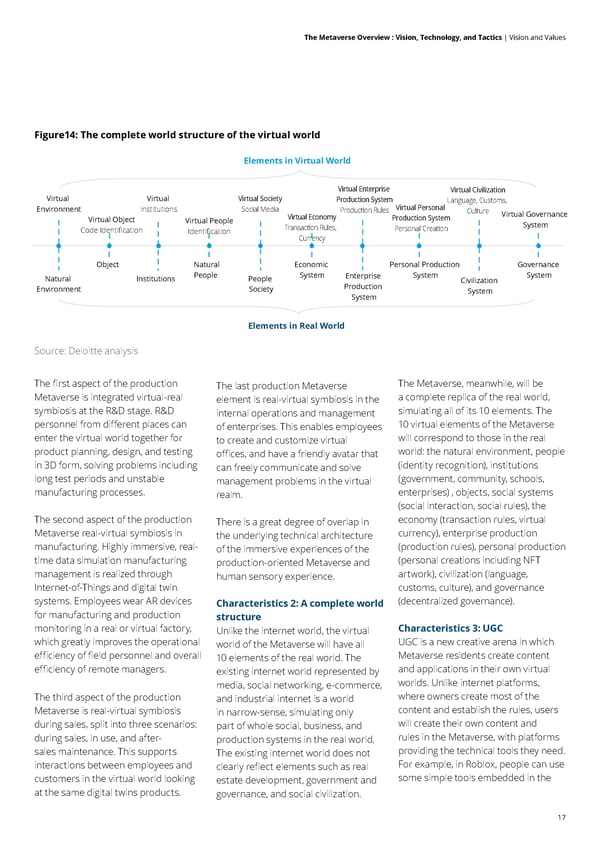17 The Metaverse Overview : Vision, Technology, and Tactics | Vision and Values The first aspect of the production Metaverse is integrated virtual-real symbiosis at the R&D stage. R&D personnel from different places can enter the virtual world together for product planning, design, and testing in 3D form, solving problems including long test periods and unstable manufacturing processes. The second aspect of the production Metaverse real-virtual symbiosis in manufacturing. Highly immersive, real- time data simulation manufacturing management is realized through Internet-of-Things and digital twin systems. Employees wear AR devices for manufacturing and production monitoring in a real or virtual factory, which greatly improves the operational efficiency of field personnel and overall efficiency of remote managers. The third aspect of the production Metaverse is real-virtual symbiosis during sales, split into three scenarios: during sales, in use, and after- sales maintenance. This supports interactions between employees and customers in the virtual world looking at the same digital twins products. The last production Metaverse element is real-virtual symbiosis in the internal operations and management of enterprises. This enables employees to create and customize virtual offices, and have a friendly avatar that can freely communicate and solve management problems in the virtual realm. There is a great degree of overlap in the underlying technical architecture of the immersive experiences of the production-oriented Metaverse and human sensory experience. Characteristics 2: A complete world structure Unlike the internet world, the virtual world of the Metaverse will have all 10 elements of the real world. The existing internet world represented by media, social networking, e-commerce, and industrial internet is a world in narrow-sense, simulating only part of whole social, business, and production systems in the real world. The existing internet world does not clearly reflect elements such as real estate development, government and governance, and social civilization. The Metaverse, meanwhile, will be a complete replica of the real world, simulating all of its 10 elements. The 10 virtual elements of the Metaverse will correspond to those in the real world: the natural environment, people (identity recognition), institutions (government, community, schools, enterprises) , objects, social systems (social interaction, social rules), the economy (transaction rules, virtual currency), enterprise production (production rules), personal production (personal creations including NFT artwork), civilization (language, customs, culture), and governance (decentralized governance). Characteristics 3: UGC UGC is a new creative arena in which Metaverse residents create content and applications in their own virtual worlds. Unlike internet platforms, where owners create most of the content and establish the rules, users will create their own content and rules in the Metaverse, with platforms providing the technical tools they need. For example, in Roblox, people can use some simple tools embedded in the Figure14: The complete world structure of the virtual world Source: Deloitte analysis Elements in Real World Elements in Virtual World Virtual Governance System Governance System Virtual Civilization Language, Customs, Culture Civilization System Virtual Personal Production System Personal Creation Personal Production System Virtual Enterprise Production System Production Rules Enterprise Production System Virtual Economy Transaction Rules, Currency Economic System Virtual Society Social Media People Society Virtual People Identification Natural People Virtual institutions Institutions Virtual Environment Natural Environment Virtual Object Code Identification Object
 Deloitte The Metaverse Overview Page 16 Page 18
Deloitte The Metaverse Overview Page 16 Page 18